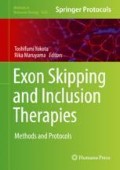Abstract
Spinal muscular atrophy (SMA) is one of the most common genetic causes of infantile death arising due to mutations in the SMN1 gene and the subsequent loss of motor neurons. With the discovery of the intronic splicing silencer N1 (ISS-N1) as a potential target for antisense therapy, several antisense oligonucleotides (ASOs) are being developed to include exon 7 in the final mRNA transcript of the SMN2 gene and thereby increasing the production of spinal motor neuron (SMN) proteins. Nusinersen (spinraza), a modified 2′-O-methoxyethyl (MOE) antisense oligonucleotide is the first drug to be approved by Food and Drug Agency (FDA) in December of 2016. Here we briefly review the pharmacological relevance of the drug, clinical trials, toxicity, and future directions following the approval of nusinersen.
Access this chapter
Tax calculation will be finalised at checkout
Purchases are for personal use only
References
Farrar MA, Park SB, Vucic S et al (2017) Emerging therapies and challenges in spinal muscular atrophy. Ann Neurol 81(3):355–368. https://doi.org/10.1002/ana.24864
Sardone V, Zhou H, Muntoni F et al (2017) Antisense oligonucleotide-based therapy for neuromuscular disease. Molecules 22(4). https://doi.org/10.3390/molecules22040563
Kolb SJ, Kissel JT (2015) Spinal muscular atrophy. Neurol Clin 33(4):831–846. https://doi.org/10.1016/j.ncl.2015.07.004
Taylor JE et al (1998) Correlation of SMNt and SMNc gene copy number with age of onset and survival in spinal muscular atrophy. Eur J Hum Genet 6:8. https://doi.org/10.1038/sj.ejhg.5200210
Ottesen EW (2017) ISS-N1 makes the first FDA-approved drug for spinal muscular atrophy. Transl Neurosci 8:1–6. https://doi.org/10.1515/tnsci-2017-0001
Lee JJ, Yokota T (2013) Antisense therapy in neurology. J Pers Med 3(3):144–176. https://doi.org/10.3390/jpm3030144
Singh NK, Singh NN, Androphy EJ et al (2006) Splicing of a critical exon of human Survival Motor Neuron is regulated by a unique silencer element located in the last intron. Mol Cell Biol 26(4):1333–1346. https://doi.org/10.1128/MCB.26.4.1333-1346.2006
Simoens S, Huys I (2017) Market access of Spinraza (Nusinersen) for spinal muscular atrophy: intellectual property rights, pricing, value and coverage considerations. Gene Ther 24:539. https://doi.org/10.1038/gt.2017.79
Chiriboga CA, Swoboda KJ, Darras BT et al (2016) Results from a phase 1 study of nusinersen (ISIS-SMN(Rx)) in children with spinal muscular atrophy. Neurology 86(10):890–897. https://doi.org/10.1212/WNL.0000000000002445
Paton DM (2017) Nusinersen: antisense oligonucleotide to increase SMN protein production in spinal muscular atrophy. Drugs Today (Barc) 53(6):327–337. https://doi.org/10.1358/dot.2017.53.6.2652413
Touznik A, Lee JJ, Yokota T (2014) New developments in exon skipping and splice modulation therapies for neuromuscular diseases. Expert Opin Biol Ther 14(6):809–819. https://doi.org/10.1517/14712598.2014.896335
Disterer P (2017) This is the dawning of the age of antisense. Oligonucleotide Therapeutics Society. Accessed 23 Jan 2018
Singh NK, Singh NN, Androphy EJ, Singh RN (2006) Splicing of a critical exon of human Survival Motor Neuron is regulated by a unique silencer element located in the last intron. Mol Cell Biol 26(4):13. https://doi.org/10.1128/MCB.26.4.1333-1346.2006
Hoy SM (2017) Nusinersen: first global approval. Drugs 77(4):473–479. https://doi.org/10.1007/s40265-017-0711-7
Touznik A, Maruyama R, Hosoki K et al (2017) LNA/DNA mixmer-based antisense oligonucleotides correct alternative splicing of the SMN2 gene and restore SMN protein expression in type 1 SMA fibroblasts. Sci Rep 7(1):3672. https://doi.org/10.1038/s41598-017-03850-2
Bob Pratt PD (2016) Risk assessment and risk mitigation review(s) FDA, Division of Risk Management (DRISK)
Hammond SM, Hazell G, Shabanpoor F et al (2016) Systemic peptide-mediated oligonucleotide therapy improves long-term survival in spinal muscular atrophy. Proc Natl Acad Sci U S A 113(39):10962–10967. https://doi.org/10.1073/pnas.1605731113
Echigoya Y, Nakamura A, Nagata T et al (2017) Effects of systemic multi-exon skipping with peptide-conjugated morpholinos in the heart of a dog model of Duchenne muscular dystrophy. Proc Natl Acad Sci U S A 114(16):4213–4218
Maruyama R, Echigoya Y, Nakamura A et al (2017) Systemic injections of peptide-conjugated morpholinos improve cardiac symptoms of a dog model of duchenne muscular dystrophy. Paper presented at the molecular therapy
Osman EY, Miller MR, Robbins KL et al (2014) Morpholino antisense oligonucleotides targeting intronic repressor Element1 improve phenotype in SMA mouse models. Hum Mol Genet 23(18):4832–4845. https://doi.org/10.1093/hmg/ddu198
Acknowledgments
This work is supported by the Slipchuk SMA Research Fund, Muscular Dystrophy Canada, the Friends of Garrett Cumming Research Fund, the HM Toupin Neurological Science Research Fund, the Canadian Institutes of Health Research (CIHR), the Alberta Innovates: Health Solutions (AIHS), the Canada Foundation for Innovation (CFI), the Alberta Advanced Education and Technology, and the Women and Children’s Health Research Institute (WCHRI).
Author information
Authors and Affiliations
Corresponding author
Editor information
Editors and Affiliations
Rights and permissions
Copyright information
© 2018 Springer Science+Business Media, LLC, part of Springer Nature
About this protocol
Cite this protocol
Goodkey, K., Aslesh, T., Maruyama, R., Yokota, T. (2018). Nusinersen in the Treatment of Spinal Muscular Atrophy. In: Yokota, T., Maruyama, R. (eds) Exon Skipping and Inclusion Therapies. Methods in Molecular Biology, vol 1828. Humana Press, New York, NY. https://doi.org/10.1007/978-1-4939-8651-4_4
Download citation
DOI: https://doi.org/10.1007/978-1-4939-8651-4_4
Published:
Publisher Name: Humana Press, New York, NY
Print ISBN: 978-1-4939-8650-7
Online ISBN: 978-1-4939-8651-4
eBook Packages: Springer Protocols

